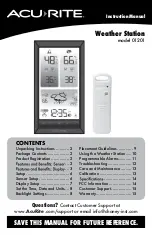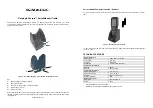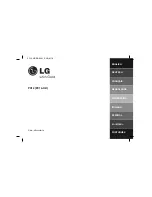
La Crosse Technology, Ltd.
Page 4
Explanation:
High outdoor temperature readings are generally a location issue. Low outdoor temperature
readings are power related or a sensors going bad.
The outdoor sensor reads the environment where it is mounted. When mounted inside the home, it
will read inside temperature/humidity.
When the outdoor sensor reads high during the day, but not at night, it is a
positioning
problem.
Look for heat sources such as sunlight, door or window frames or reflected heat.
Side-by-side test:
Bring the outdoor sensor in the house and place it next to the weather station for 2
hours.
Compare indoor and outdoor temperature. The temperatures should be within 4 degrees to be within
tolerance.
If the outdoor sensor reads correctly when next to the weather station, try a different location outside.
Intermittent Outdoor Temperature/Humidity
Explanation:
Intermittent problems are the hardest to resolve. RF (radio frequency) communication may
come and go occasionally. This can be normal in some environments (e.g. moister climates). If outdoor
sensor signal is lost, please wait 2-4 hours for the signal to reconnect on its own.
Check
Confirm that the channel selected on the outdoor transmitter matches the channel
shown on the forecast station.
Move the outdoor transmitter to a closer location.
Freezer test:
Confirm the forecast station is reading the correct outdoor transmitter. Place the
transmitter in the freezer for an hour and watch the temperature drop on the forecast station.
Indoor distance test:
Please complete the
with transmitter and forecast station5-10 feet
apart and inside to establish a strong connection.
If there is a reading in the outdoor temperature area after 15 minutes, move the transmitter to another
room with one wall between the transmitter and the forecast station. Observe to see if the
temperature remains on consistently for 1 hour.
If the temperature remains on while in the house, then it is likely a
the transmitter to different locations outside to find a location where the temperature reading will hold.
can cause loss of transmitter signal.
Outdoor Temperature is stuck or HH.H or LL.L
Explanation:
These symbols are error messages indication the outdoor sensor is outside of its readable
range.
Overpowered or underpowered batteries can cause this reading.
Replace outdoor sensor.
Note:
The last outdoor reading may remain (not change) for several hours when connection is lost. The
outdoor temperature reading will flash when the connection is first lost or intermittent.
Outdoor transmitter fell and does not work.
Explanation:
If there is no physical damage to the outdoor sensor, the fall may not have caused internal
damage. A fall can shock the outdoor sensor or the batteries in the outdoor sensor. Batteries that have
fallen on a hard surface may be damaged and unable to function properly.
Complete a
Use
dated at least six years in advance of the current year. Batteries dated earlier than six
years from now may still work, but may be unstable in performance.
Note:
An outdoor sensor that has fallen into puddle, snow, or other standing water, will likely have water
damage and needs to be replaced. Outdoor sensors are water resistant, not waterproof.
Outdoor transmitter drains batteries quickly































